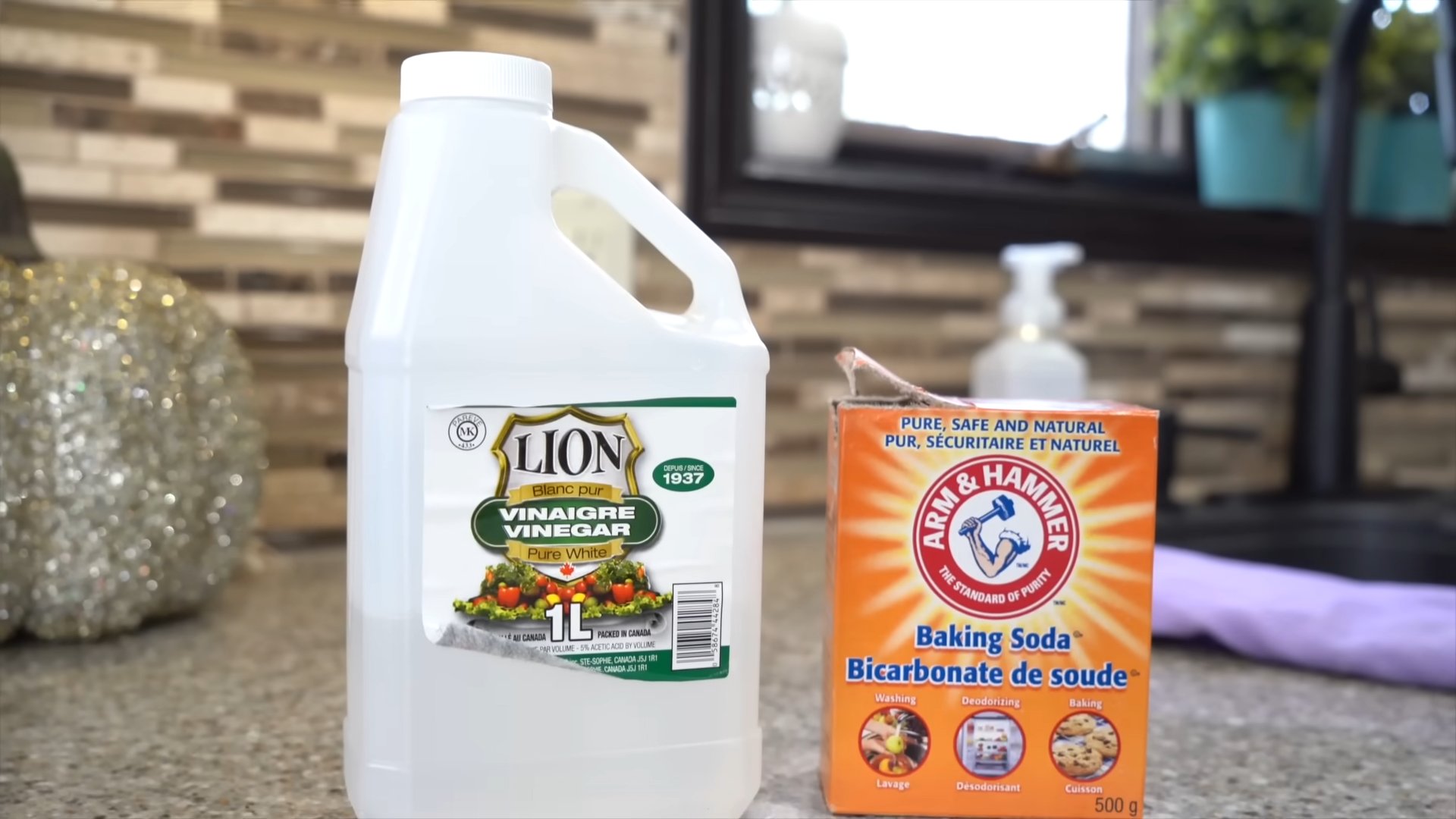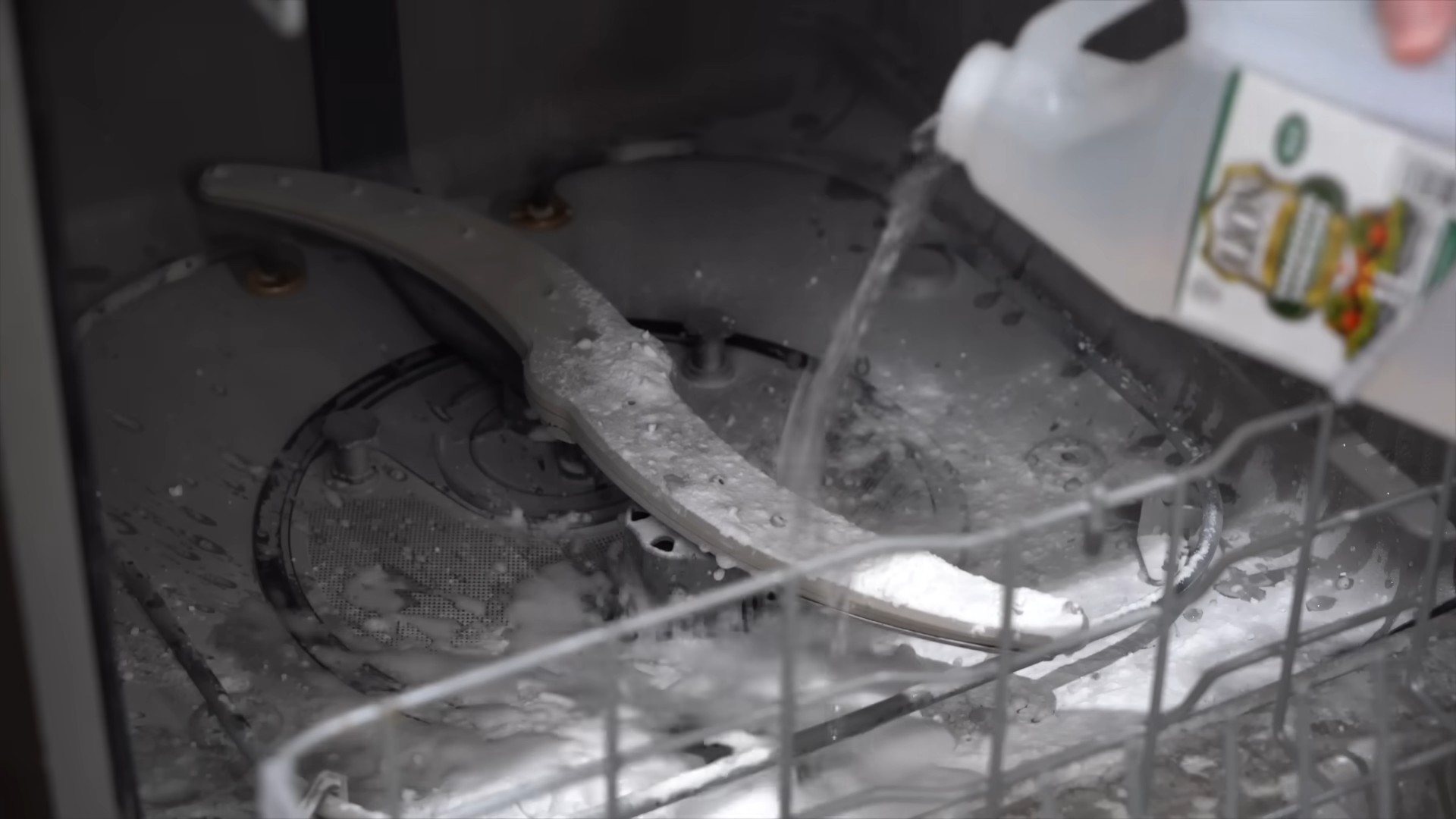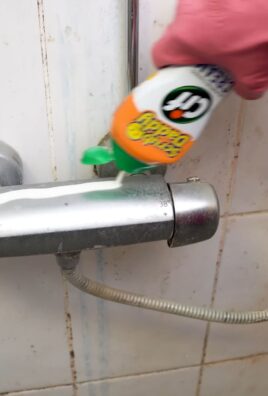Baking Soda Vinegar Tricks: Unlock the secrets to a sparkling home and thriving garden with these simple, yet powerful DIY solutions! Have you ever looked at a stubborn stain or a wilting plant and wished you had a magic wand? Well, you might be surprised to learn that the answer is likely already sitting in your pantry.
For generations, baking soda and vinegar have been household staples, used for everything from baking delicious treats to cleaning grime. Their versatility stems from their unique chemical properties – baking soda is a mild alkali, while vinegar is a weak acid. When combined, they create a fizzing reaction that can lift dirt, neutralize odors, and even boost plant growth! Think of it as a natural, eco-friendly power couple ready to tackle your toughest challenges.
In today’s world, where we’re all striving for sustainability and cost-effectiveness, mastering these baking soda vinegar tricks is more important than ever. Why spend a fortune on harsh chemicals when you can achieve amazing results with these readily available, budget-friendly ingredients? I’m excited to share some of my favorite DIY hacks that will transform your home and garden, making your life easier and greener. Get ready to discover the magic of baking soda and vinegar!

Unleash the Power of Baking Soda and Vinegar: DIY Cleaning and Refreshing Hacks!
Hey there, fellow DIY enthusiasts! I’m so excited to share some of my favorite cleaning and refreshing hacks using the dynamic duo: baking soda and vinegar. These two humble ingredients are absolute powerhouses when it comes to tackling household chores, and the best part? They’re eco-friendly and budget-friendly! Let’s dive in and discover the magic!
Cleaning Your Grout Like a Pro
Tired of dingy, stained grout lines? This is my go-to method for bringing them back to life.
* The Problem: Grout is porous and easily absorbs dirt, grime, and spills, leading to discoloration and an overall unclean look.
* The Solution: Baking soda’s mild abrasive properties combined with vinegar’s acidity create a fizzing action that loosens stubborn stains.
Step-by-Step Grout Cleaning Guide
1. Prepare the Paste: In a small bowl, mix baking soda and water to form a thick paste. The consistency should be similar to toothpaste. I usually start with about 1/2 cup of baking soda and add water gradually until I get the right consistency.
2. Apply the Paste: Using an old toothbrush or a grout brush, apply the baking soda paste generously to the grout lines. Make sure to cover the entire area you want to clean.
3. Let it Sit: Allow the paste to sit on the grout for at least 10-15 minutes. This gives the baking soda time to penetrate the stains and loosen the grime. For really tough stains, you can let it sit for up to 30 minutes.
4. Vinegar Power: Fill a spray bottle with white vinegar. Lightly spray the baking soda-covered grout lines with vinegar. You’ll notice a fizzing reaction – that’s the magic happening!
5. Scrub-a-dub-dub: Using the toothbrush or grout brush, scrub the grout lines vigorously. The fizzing action will help lift the dirt and grime. I like to use small, circular motions for the best results.
6. Rinse Thoroughly: Rinse the area with clean water. You can use a damp sponge or cloth to wipe away any remaining baking soda and vinegar residue.
7. Dry and Admire: Dry the area with a clean towel. Step back and admire your sparkling clean grout! You might be surprised at the difference.
Unclogging Drains the Natural Way
Forget harsh chemical drain cleaners! This baking soda and vinegar method is a safer and more effective alternative.
* The Problem: Drains get clogged with hair, grease, and other debris, leading to slow drainage and unpleasant odors.
* The Solution: The baking soda and vinegar reaction creates pressure that helps dislodge the clog.
Step-by-Step Drain Unclogging Guide
1. Clear the Area: Remove any standing water from the sink or tub.
2. Baking Soda First: Pour about 1 cup of baking soda down the drain. Try to get as much of it down the drain as possible.
3. Vinegar Chaser: Immediately follow with 1 cup of white vinegar.
4. Fizzing Time: Let the mixture fizz for about 30 minutes. You might want to cover the drain with a plug or cloth to contain the fizzing action.
5. Hot Water Flush: After 30 minutes, pour a pot of boiling water down the drain. This will help flush away the loosened debris.
6. Repeat if Necessary: If the drain is still clogged, repeat the process. For stubborn clogs, you might need to repeat it a few times.
7. Prevention is Key: To prevent future clogs, flush your drains with hot water regularly and avoid pouring grease down the drain.
Freshening Your Mattress for a Better Night’s Sleep
Give your mattress a refresh with this simple baking soda trick.
* The Problem: Mattresses can accumulate dust mites, odors, and moisture over time, affecting sleep quality and hygiene.
* The Solution: Baking soda absorbs odors and moisture, leaving your mattress feeling fresh and clean.
Step-by-Step Mattress Freshening Guide
1. Strip the Bed: Remove all bedding, including sheets, blankets, and pillows.
2. Vacuum Thoroughly: Vacuum the entire surface of the mattress, including the sides and any crevices. This will remove loose dust and debris.
3. Baking Soda Blanket: Sprinkle a generous layer of baking soda over the entire mattress surface. I like to use a sifter to ensure even distribution.
4. Let it Sit (and Work its Magic): Allow the baking soda to sit on the mattress for at least 4-6 hours, or even overnight for best results. The longer it sits, the more odors and moisture it will absorb.
5. Vacuum Again: Vacuum the mattress thoroughly to remove all the baking soda. Use the hose attachment to get into any crevices.
6. Optional: Sunbath: If possible, place your mattress in direct sunlight for a few hours. Sunlight has natural disinfecting properties and can help further freshen the mattress.
7. Fresh Bedding: Put on fresh, clean bedding and enjoy your refreshed mattress!
Cleaning Burnt Food from Pots and Pans
Don’t throw away that burnt pot! Baking soda and vinegar can often save the day.
* The Problem: Burnt food can be incredibly difficult to remove from pots and pans.
* The Solution: Baking soda’s abrasive properties and vinegar’s acidity help loosen the burnt food, making it easier to scrub away.
Step-by-Step Burnt Food Removal Guide
1. Assess the Damage: Determine the severity of the burnt food. For lightly burnt food, you might be able to skip the vinegar step.
2. Baking Soda Soak: Sprinkle a generous amount of baking soda over the burnt food in the pot or pan.
3. Vinegar Addition: Add enough white vinegar to cover the burnt food.
4. Simmering Action: Place the pot or pan on the stovetop and bring the mixture to a simmer. Let it simmer for about 10-15 minutes. The simmering action will help loosen the burnt food.
5. Cool Down: Remove the pot or pan from the heat and let it cool down completely.
6. Scrubbing Time: Use a non-abrasive sponge or scrubber to scrub away the burnt food. The baking soda and vinegar should have loosened it enough to make it easier to remove.
7. Repeat if Necessary: For stubborn burnt food, you might need to repeat the process or let the baking soda and vinegar soak overnight.
8. Wash and Dry: Wash the pot or pan with soap and water and dry it thoroughly.
Deodorizing Your Refrigerator
Say goodbye to funky fridge smells with this simple baking soda solution.
* The Problem: Refrigerators can develop unpleasant odors from spilled food, leftovers, and other sources.
* The Solution: Baking soda absorbs odors, leaving your refrigerator smelling fresh and clean.
Step-by-Step Refrigerator Deodorizing Guide
1. Identify the Source: If possible, try to identify the source of the odor and remove any spoiled food or spills.
2. Baking Soda Box: Open a box of baking soda and place it in the back of your refrigerator.
3. Odor Absorption: Let the baking soda sit in the refrigerator for at least 24 hours, or longer for stronger odors.
4. Regular Replacement: Replace the box of baking soda every month or two to maintain a fresh-smelling refrigerator.
5. Baking Soda Paste for Spills: For stubborn spills or odors, you can make a paste of baking soda and water and apply it to the affected area. Let it sit for a few minutes, then wipe it away with a damp cloth.
Cleaning Your Microwave with Ease
This is a super quick and easy way to clean your microwave.
* The Problem: Microwaves can get splattered with food and grease, making them difficult to clean.
* The Solution: The steam created by the baking soda and vinegar mixture loosens the grime, making it easy to wipe away.
Step-by-Step Microwave Cleaning Guide
1. Baking Soda Solution: In a microwave-safe bowl, mix 1 tablespoon of baking soda with 1 cup of water.
2. Microwave Magic: Place the bowl in the microwave and heat it on high for 3-5 minutes, or until the solution comes to a boil.
3. Steam Power: Let the bowl sit in the microwave for another 5-10 minutes with the door closed. The steam will loosen the grime and grease.
4. Wipe Away: Carefully remove

Conclusion
So, there you have it! Unlocking the power of baking soda and vinegar isn’t just about revisiting a classic science experiment; it’s about embracing a simple, effective, and eco-friendly approach to countless household tasks. From tackling stubborn stains to revitalizing your drains, the versatility of this dynamic duo is truly remarkable. We’ve explored a range of applications, demonstrating how these readily available ingredients can replace harsh chemicals and save you money in the process.
But why is this baking soda vinegar trick a must-try? Because it’s more than just a cleaning solution; it’s a sustainable lifestyle choice. It’s about reducing your reliance on potentially harmful products and opting for a natural alternative that’s gentle on your home and the environment. Plus, the satisfaction of seeing those bubbles fizz away as grime disappears is undeniably rewarding!
Don’t be afraid to experiment and adapt these techniques to suit your specific needs. For instance, if you’re dealing with particularly stubborn mildew in the bathroom, try creating a paste of baking soda and water, applying it to the affected area, and then spraying it with vinegar. Let it sit for a few minutes before scrubbing and rinsing. For a refreshing twist on drain cleaning, add a few drops of your favorite essential oil, like lemon or lavender, to the baking soda before pouring in the vinegar. This will leave your drains smelling fresh and clean.
Consider these variations as starting points. You can also try using different types of vinegar, such as apple cider vinegar, for specific tasks. Apple cider vinegar, for example, is known for its deodorizing properties and can be particularly effective in eliminating lingering odors in your kitchen. Remember to always test a small, inconspicuous area first, especially when working with delicate surfaces or fabrics.
The possibilities are endless, and the results are often astonishing. We encourage you to embrace the power of baking soda and vinegar and discover the many ways they can simplify your life and create a healthier home.
Now, it’s your turn! We’re eager to hear about your experiences with these DIY tricks. Did you discover a new application for baking soda and vinegar? Did you find a variation that worked particularly well for a specific task? Share your tips, tricks, and success stories in the comments below. Let’s build a community of eco-conscious individuals who are passionate about harnessing the power of natural solutions. Your insights could inspire others to ditch the harsh chemicals and embrace the simplicity and effectiveness of baking soda and vinegar. So, go ahead, give it a try, and let us know what you think! We can’t wait to hear from you.
Frequently Asked Questions (FAQs)
What exactly makes baking soda and vinegar such a powerful cleaning combination?
The magic lies in their chemical reaction. Baking soda (sodium bicarbonate) is a mild alkali, while vinegar (acetic acid) is a mild acid. When they combine, they create carbon dioxide gas and water. The fizzing action of the carbon dioxide helps to loosen dirt, grime, and debris, making it easier to wipe away. The mild acidity of the vinegar also helps to dissolve mineral deposits and kill some types of bacteria and mold. However, it’s important to note that while effective for many cleaning tasks, this combination isn’t a disinfectant in the same way as bleach or other stronger chemicals.
Is it safe to use baking soda and vinegar on all surfaces?
While generally safe, it’s always best to test a small, inconspicuous area first, especially on delicate surfaces like marble, granite, or waxed wood. The acidity of vinegar can potentially etch or dull these surfaces over time. Avoid using baking soda and vinegar on aluminum, as the baking soda can cause discoloration. For these surfaces, a gentler cleaning solution is recommended.
Can I store a mixture of baking soda and vinegar for later use?
No, it’s not recommended to store a pre-mixed solution of baking soda and vinegar. The chemical reaction between the two ingredients will continue until one of them is completely used up, resulting in a solution of mostly water and sodium acetate. This solution will have significantly reduced cleaning power. It’s best to mix baking soda and vinegar immediately before use to maximize their effectiveness.
What’s the best ratio of baking soda to vinegar for different cleaning tasks?
The ideal ratio depends on the specific task. For drain cleaning, a common recommendation is to use about 1/2 cup of baking soda followed by 1 cup of vinegar. For general cleaning, you can create a paste of baking soda and water, or use a solution of equal parts vinegar and water. Experiment to find the ratio that works best for your needs.
Will baking soda and vinegar unclog a severely blocked drain?
While baking soda and vinegar can be effective for clearing minor clogs, they may not be sufficient for severely blocked drains. For stubborn clogs, you may need to use a drain snake or call a professional plumber. However, regular use of baking soda and vinegar can help prevent clogs from forming in the first place.
Are there any safety precautions I should take when using baking soda and vinegar?
While baking soda and vinegar are generally safe, it’s always a good idea to wear gloves, especially if you have sensitive skin. Avoid getting the mixture in your eyes, and if you do, rinse thoroughly with water. Never mix baking soda and vinegar in a closed container, as the build-up of carbon dioxide gas can cause the container to explode.
Can I use baking soda and vinegar to clean my oven?
Yes, baking soda and vinegar can be used to clean your oven. First, remove any loose debris from the oven. Then, make a paste of baking soda and water and spread it evenly over the interior surfaces of the oven, avoiding the heating elements. Let the paste sit overnight. The next day, spray the baking soda paste with vinegar and watch it fizz. Wipe away the loosened grime with a damp cloth.
Is there a difference between white vinegar and other types of vinegar for cleaning?
White vinegar is generally the best choice for cleaning due to its higher acidity and lack of coloring agents. Other types of vinegar, such as apple cider vinegar, can also be used, but they may leave a slight odor or discoloration on some surfaces.
Can I use baking soda and vinegar to remove stains from clothing?
Yes, baking soda and vinegar can be used to remove stains from clothing. For a stain remover, create a paste of baking soda and water and apply it to the stain. Let it sit for a few minutes before rinsing. You can also add 1/2 cup of vinegar to your washing machine during the rinse cycle to help brighten clothes and remove odors. Always test a small, inconspicuous area of the fabric first to ensure that the baking soda and vinegar don’t cause any discoloration.
How often should I use baking soda and vinegar to clean my drains?
To prevent clogs from forming, it’s recommended to clean your drains with baking soda and vinegar about once a month. This will help to keep your drains flowing smoothly and prevent the build-up of grease, hair, and other debris.





Leave a Comment